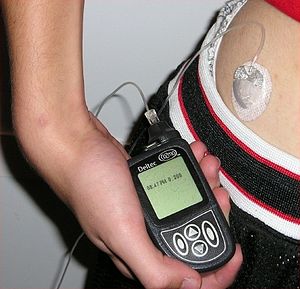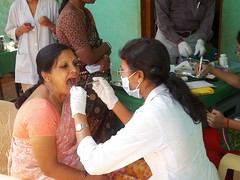 In the United States, the number of patients diagnosed with diabetes (both Type 1 and Type 2) has doubled over the last decade. Type 2 accounts for 90-95% of all diabetes diagnoses. Over eight percent of the U.S. population is believed to have diabetes, and of those with it, an estimated 27% do not even know it. Monitoring blood glucose levels is critically important and must be done multiple times a day, which can be painful and cumbersome. Google has just announced a prototype device that retrieves information about blood sugar directly from the eyeball, via a contact lens.
In the United States, the number of patients diagnosed with diabetes (both Type 1 and Type 2) has doubled over the last decade. Type 2 accounts for 90-95% of all diabetes diagnoses. Over eight percent of the U.S. population is believed to have diabetes, and of those with it, an estimated 27% do not even know it. Monitoring blood glucose levels is critically important and must be done multiple times a day, which can be painful and cumbersome. Google has just announced a prototype device that retrieves information about blood sugar directly from the eyeball, via a contact lens.
Typically, a small blood sample is taken from the fingertip using a combination of a lancet, strips, and a blood glucose meter. For those who have had diabetes for a long time or require more frequent testing, it can be hard to find a spot that will bleed easily. There are embedded blood glucose monitors, but they require a device to be taped to the skin or work on a belt and require outpatient surgery for replacement. Unfortunately, because properly monitoring blood sugar is such a large commitment, many people are not doing it right. Those who choose not to manage their disease properly are at a much greater risk of developing blindness, kidney failure, or having their lower extremities amputated.
Many researchers have been seeking alternative ways to monitor glucose without the use of blood, in order to make it easier for diabetics to stay on top of their sugar levels. Some newer noninvasive glucose tests include checking saliva, urine, or tears. Tears can provide an incredibly accurate measurement, but it is not always easy to get a sample. Google’s solution to using tears is minimally invasive and can provide constant monitoring of glucose levels.
A prototype soft contact lens has been outfitted with a micro-scale computer chip, sensor, and an antenna. Once every second, the sensor monitors the glucose levels in the tears and transmits the information to a wireless device, such as a smart phone. This information could also be sent directly to the person’s doctor. Future prototypes may also include a tiny LED which would immediately alert the wearer that sugar levels are either too low or too high and to take immediate action. The technology within the lens does not impact the field of vision and should not be much different than wearing traditional contact lenses.
Currently, scientists at Google are in talks with the FDA about taking this prototype to the next level. It will be years before the contact will be available for clinical use. Google is reaching out to potential partners in order to make this a feasible option for diabetics. This has the potential to revolutionize how millions of people with diabetes manage their disease and give them the best chance to protect their eyesight, limbs, and life.
- See more at: http://www.iflscience.com/health-and-medicine/new-smart-contact-lens-could-monitor-glucose-diabetics#overlay-context=
















 In the first step toward animal-to-human transplants of insulin-producing cells for people with type 1 diabetes, Northwestern Medicine® scientists have successfully transplanted islets, the cells that produce insulin, from one species to another. And the islets survived without immunosuppressive drugs.
In the first step toward animal-to-human transplants of insulin-producing cells for people with type 1 diabetes, Northwestern Medicine® scientists have successfully transplanted islets, the cells that produce insulin, from one species to another. And the islets survived without immunosuppressive drugs.


 Cell phones and computer programs give specific advice and support to people with diabetes, but do not do much to improve their health or quality of life, new research suggests.
Cell phones and computer programs give specific advice and support to people with diabetes, but do not do much to improve their health or quality of life, new research suggests.
 In a study of
In a study of  If you're pulling and all-nighter to finish a term paper, a new parent up all night with a fussy baby, or simply can't sleep like you once could, then you may be snoozing on good health. That's because new research published in The FASEB Journal used mice to show that proper sleep patterns are critical for healthy metabolic function, and even mild impairment in our circadian rhythms can lead to serious health consequences, including diabetes and obesity.
If you're pulling and all-nighter to finish a term paper, a new parent up all night with a fussy baby, or simply can't sleep like you once could, then you may be snoozing on good health. That's because new research published in The FASEB Journal used mice to show that proper sleep patterns are critical for healthy metabolic function, and even mild impairment in our circadian rhythms can lead to serious health consequences, including diabetes and obesity. Seeing a doctor within a month of an
Seeing a doctor within a month of an  Adult patients with diabetes who don't understand basic health information are significantly less likely to take newly prescribed antidepressant medication, according to a new
Adult patients with diabetes who don't understand basic health information are significantly less likely to take newly prescribed antidepressant medication, according to a new  Only one in ten are studying prevention while almost two thirds focus on drug therapy
Only one in ten are studying prevention while almost two thirds focus on drug therapy Patients with type 2 diabetes who follow the same strict diet required for those who undergo bariatric surgery are just as likely to see a reduction in blood glucose levels.
Patients with type 2 diabetes who follow the same strict diet required for those who undergo bariatric surgery are just as likely to see a reduction in blood glucose levels. Depression in a group of Medicare recipients ages 65 years and older appears to be associated with prevalent mild cognitive impairment and an increased risk of dementia, according to a report published Online First by Archives of Neurology, a JAMA Network publication.
Depression in a group of Medicare recipients ages 65 years and older appears to be associated with prevalent mild cognitive impairment and an increased risk of dementia, according to a report published Online First by Archives of Neurology, a JAMA Network publication.
 Young adults with Type 1 diabetes are much more likely to die than their peers because they are not getting the healthcare they need to manage their condition.
Young adults with Type 1 diabetes are much more likely to die than their peers because they are not getting the healthcare they need to manage their condition.  Amelia Lily, popstar and children’s ambassador for Diabetes UK, said, "As someone who has Type 1 diabetes myself, I know that no family should have to struggle to get the good care their child deserves. But that’s what thousands of families with children with Type 1 diabetes have to do year in, year out.
Amelia Lily, popstar and children’s ambassador for Diabetes UK, said, "As someone who has Type 1 diabetes myself, I know that no family should have to struggle to get the good care their child deserves. But that’s what thousands of families with children with Type 1 diabetes have to do year in, year out.  Women who were diagnosed with gestational diabetes during
Women who were diagnosed with gestational diabetes during 





